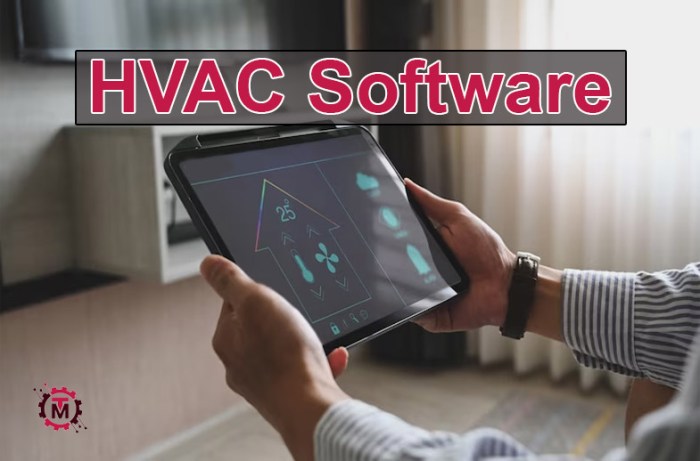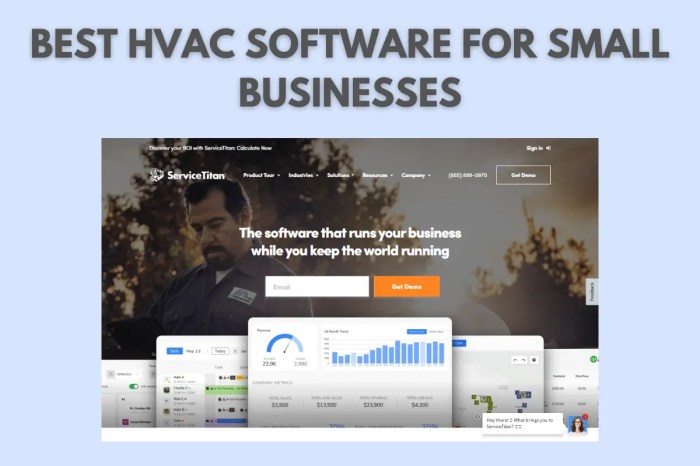Exploring HVAC Software for Small Businesses: Streamlining Operations and Boosting Profits, this guide delves into the world of HVAC software, specifically tailored for the needs of small businesses. In an industry characterized by complex systems and fluctuating demands, efficient management is paramount.
HVAC software emerges as a powerful tool, capable of automating tasks, improving efficiency, and ultimately, driving profitability.
From scheduling maintenance to managing inventory and generating insightful reports, HVAC software empowers small businesses to streamline their operations and achieve their goals. This comprehensive guide will explore the key features, benefits, and considerations involved in choosing and implementing the right HVAC software for your business.
Understanding HVAC Software Needs for Small Businesses

Small businesses face unique challenges when it comes to managing their HVAC systems. Unlike larger companies with dedicated maintenance teams, smaller businesses often rely on a single individual or a small team to handle everything from scheduling routine maintenance to responding to emergencies.
This can lead to a lack of organization, difficulty tracking costs, and potential delays in addressing critical issues.
HVAC Software for Simplifying Tasks
HVAC software can help small businesses streamline their HVAC operations and overcome these challenges. By automating or simplifying various tasks, these tools can free up valuable time and resources, allowing businesses to focus on their core operations. Here are some examples of common HVAC-related tasks that software can automate or simplify:
- Scheduling maintenance:HVAC software can help businesses schedule routine maintenance appointments, ensuring that systems are regularly serviced and maintained to prevent breakdowns and extend their lifespan. This can also help businesses track maintenance costs and identify areas where they can save money.
- Tracking equipment history:Software can maintain a comprehensive record of all HVAC equipment, including installation dates, maintenance records, and repair history. This information can be invaluable for making informed decisions about equipment upgrades or replacements, as well as for troubleshooting issues.
- Managing inventory:HVAC software can help businesses manage their inventory of parts and supplies, ensuring that they have the necessary materials on hand to address maintenance and repair needs promptly. This can also help businesses track inventory costs and identify areas where they can optimize their purchasing practices.
- Generating reports:HVAC software can generate reports on a variety of metrics, such as maintenance costs, equipment performance, and energy consumption. This data can be used to identify areas for improvement and make data-driven decisions about HVAC operations.
Essential Features of HVAC Software
The specific features of HVAC software will vary depending on the needs of the individual business. However, some key functionalities are essential for most small businesses:
- Work order management:This feature allows businesses to create, assign, and track work orders for maintenance, repairs, and installations. It helps to ensure that all tasks are completed efficiently and on time.
- Customer management:This feature enables businesses to manage customer information, including contact details, service history, and billing information. It helps to streamline customer interactions and provide personalized service.
- Inventory management:This feature allows businesses to track their inventory of parts and supplies, ensuring that they have the necessary materials on hand to address maintenance and repair needs promptly. It can also help businesses track inventory costs and identify areas where they can optimize their purchasing practices.
- Reporting and analytics:This feature provides businesses with valuable insights into their HVAC operations, allowing them to track key metrics such as maintenance costs, equipment performance, and energy consumption. This data can be used to identify areas for improvement and make data-driven decisions about HVAC operations.
- Mobile access:This feature allows businesses to access and manage their HVAC software from any location with an internet connection. This is particularly useful for technicians who are on the go, as it allows them to access customer information, create work orders, and track their progress in real time.
Key Features and Benefits of HVAC Software

HVAC software is designed to streamline operations, improve efficiency, and enhance customer satisfaction for small businesses in the HVAC industry. By automating tasks, providing valuable insights, and facilitating better communication, this software can significantly contribute to a company’s growth and success.
Scheduling and Dispatch
Scheduling and dispatch are crucial for HVAC businesses, as they ensure technicians are deployed efficiently and appointments are managed effectively. HVAC software streamlines these processes by:
- Centralized Scheduling:All appointments are stored in a single system, eliminating double-booking and ensuring technicians have access to the latest schedule.
- Automated Reminders:Software sends automatic reminders to customers about upcoming appointments, reducing missed appointments and improving customer satisfaction.
- Real-time Tracking:Technicians can be tracked in real-time, allowing dispatchers to optimize routes and provide accurate arrival estimates to customers.
- Mobile Access:Technicians can access the schedule and update their status through mobile apps, enhancing their efficiency and responsiveness.
Maintenance Tracking
Effective maintenance tracking is essential for maximizing equipment lifespan, preventing breakdowns, and ensuring customer satisfaction. HVAC software facilitates this by:
- Equipment Records:Software stores detailed information about each piece of equipment, including installation date, maintenance history, and warranty details.
- Automated Reminders:The software automatically sends reminders for scheduled maintenance, ensuring timely servicing and preventing potential issues.
- Service History:All service records are stored digitally, providing a comprehensive history of each equipment’s maintenance and repairs.
- Preventive Maintenance Scheduling:Software allows for scheduling preventative maintenance based on equipment type, usage, and manufacturer recommendations.
Inventory Management
Efficient inventory management is crucial for minimizing costs, preventing stockouts, and ensuring timely service delivery. HVAC software offers several features to optimize inventory:
- Real-time Inventory Tracking:Software provides a real-time view of available inventory, allowing for accurate ordering and reducing the risk of stockouts.
- Automated Reordering:The software can automatically place orders when inventory levels fall below a predetermined threshold, minimizing manual intervention and ensuring timely replenishment.
- Part Tracking:Each part can be tracked individually, including its cost, supplier, and usage history, providing valuable insights for inventory management.
- Cost Analysis:Software analyzes inventory costs, identifying areas for potential savings and optimizing purchasing decisions.
Reporting and Analytics
Comprehensive reporting and analytics provide valuable insights into business performance, enabling informed decision-making and continuous improvement. HVAC software offers various reporting features:
- Performance Metrics:Software tracks key metrics such as service call volume, technician productivity, and customer satisfaction, providing a comprehensive overview of business performance.
- Financial Reports:The software generates detailed financial reports, including revenue, expenses, and profitability, enabling financial analysis and informed decision-making.
- Customer Data:Software collects and analyzes customer data, providing insights into customer preferences, service needs, and satisfaction levels.
- Trend Analysis:Software analyzes historical data to identify trends and patterns, allowing for proactive planning and optimization of operations.
Choosing the Right HVAC Software for Your Business
Finding the perfect HVAC software for your small business can be a daunting task. With numerous options available, it’s essential to consider your specific needs and budget to make an informed decision.
Evaluating Your Business Needs
To choose the right software, you must first understand your specific requirements.
- Identify your pain points:What are the challenges you face in your current workflow? Are you struggling with scheduling, dispatching, invoicing, or customer management?
- Define your goals:What do you hope to achieve with HVAC software? Improved efficiency, better customer service, increased revenue, or a combination of these?
- Assess your budget:Determine how much you’re willing to spend on software and consider the long-term return on investment.
Key Factors to Consider, Exploring HVAC Software for Small Businesses
Once you understand your needs, you can evaluate software solutions based on the following key factors:
| Factor | Description |
|---|---|
| Pricing | Consider subscription models, upfront costs, and any additional fees. Look for transparent pricing structures and compare value for money. |
| Features | Ensure the software offers the functionalities you need, including scheduling, dispatching, inventory management, invoicing, customer relationship management (CRM), reporting, and mobile accessibility. |
| Integration Capabilities | Check if the software integrates with other tools you use, such as accounting software, payment gateways, or marketing platforms. Seamless integration streamlines workflows and reduces manual data entry. |
| Customer Support | Evaluate the quality of customer support offered, including response time, availability, and the availability of resources like online documentation, tutorials, and webinars. |
Popular HVAC Software Solutions
Here are some examples of popular HVAC software solutions, along with their key strengths and weaknesses:
- FieldEdge:FieldEdge is a comprehensive solution with a wide range of features, including scheduling, dispatching, invoicing, CRM, and mobile accessibility. It’s known for its user-friendly interface and strong customer support. However, it can be relatively expensive for smaller businesses.
- ServiceTitan:ServiceTitan is another popular choice, offering similar features to FieldEdge. It’s particularly strong in marketing automation and customer engagement. However, it can be complex to learn and requires a significant investment.
- Jobber:Jobber is a more affordable option, offering essential features like scheduling, dispatching, and invoicing. It’s easy to use and integrates well with other tools. However, it lacks some advanced features found in more comprehensive solutions.
Implementing and Utilizing HVAC Software

Successfully implementing HVAC software is crucial for small businesses to streamline operations, enhance efficiency, and boost profitability. The key lies in careful planning, effective training, and leveraging the data insights generated by the software.
Integrating HVAC Software into Existing Workflows
Integrating HVAC software seamlessly into your existing workflows is vital for a smooth transition and maximum impact. This involves:
- Mapping Out Processes:Carefully analyze your current workflows, identifying key processes related to customer interactions, scheduling, service requests, billing, and inventory management. This allows you to tailor the software implementation to your specific needs.
- Streamlining Data Entry:Minimize data entry duplication by integrating the software with your existing systems. This could involve using APIs to connect with your CRM, accounting software, or other relevant platforms.
- Phased Implementation:Avoid overwhelming your team by implementing the software in phases. Start with core functionalities and gradually introduce additional features as your team gains familiarity and comfort with the system.
Training Staff on HVAC Software
Effective training is paramount to ensure your staff can utilize the software efficiently and reap its full benefits. A structured training program should include:
- Hands-on Training:Provide practical, hands-on training sessions using real-world scenarios. This allows your team to gain practical experience and address any challenges they may encounter.
- Interactive Tutorials:Leverage interactive tutorials and online resources to supplement formal training. This allows staff to revisit key concepts and access information at their own pace.
- Ongoing Support:Offer ongoing support through dedicated support channels, FAQs, and user manuals. This ensures your team has access to the resources they need to overcome any technical challenges or answer questions.
Leveraging Data and Analytics for Informed Decisions
HVAC software generates valuable data and analytics that can provide insights into your business operations, enabling you to make informed decisions. This involves:
- Tracking Key Performance Indicators (KPIs):Monitor KPIs such as customer satisfaction, service response time, technician efficiency, and inventory levels. This provides a comprehensive view of your business performance and identifies areas for improvement.
- Analyzing Trends:Use the software’s data analytics features to identify trends in customer behavior, service requests, and inventory usage. This allows you to anticipate future needs and optimize your operations accordingly.
- Predictive Maintenance:Leverage data on equipment performance and maintenance history to predict potential failures. This allows you to schedule preventive maintenance proactively, reducing downtime and minimizing costly repairs.
Case Studies
To truly understand the impact of HVAC software on small businesses, let’s delve into real-world examples. These case studies demonstrate how businesses have successfully implemented HVAC software and the tangible benefits they’ve reaped.
Examples of HVAC Software Success Stories
Here are a few examples of how small HVAC businesses have utilized software to improve their operations:
- ABC Heating and Cooling, a family-owned business in a mid-sized city, struggled with managing service calls, scheduling technicians, and tracking inventory. They implemented HVAC software that automated scheduling, provided real-time inventory updates, and allowed them to track customer history. This resulted in a 20% reduction in missed appointments, a 15% increase in technician efficiency, and a 10% decrease in inventory waste.
- Green Energy Solutions, a small but growing company specializing in energy-efficient HVAC systems, faced challenges with generating accurate quotes and managing customer relationships. By using HVAC software with integrated quoting tools and customer relationship management (CRM) features, they were able to streamline the quoting process, improve communication with customers, and increase their closing rate by 15%.
- Comfort Zone HVAC, a small business serving a rural area, previously relied on paper-based systems for managing their operations. Implementing HVAC software enabled them to go paperless, improve communication with customers through online scheduling and service updates, and gain valuable insights into their business performance through comprehensive reporting features.
Benefits and Challenges of HVAC Software Adoption
| Business | Key Benefits | Challenges Encountered |
|---|---|---|
| ABC Heating and Cooling | Increased efficiency, reduced missed appointments, improved inventory management | Initial training required for staff, integrating with existing systems |
| Green Energy Solutions | Streamlined quoting process, improved customer communication, increased closing rate | Finding a software that met their specific needs, managing data migration |
| Comfort Zone HVAC | Improved communication, streamlined operations, data-driven insights | Initial cost of software, learning curve for new software |
Wrap-Up: Exploring HVAC Software For Small Businesses
By leveraging the power of HVAC software, small businesses can transform their operations, enhancing efficiency, reducing costs, and elevating customer satisfaction. From automating tasks to gaining valuable insights, the benefits are undeniable. As you embark on your journey to explore and implement HVAC software, remember to carefully assess your specific needs, choose a solution that aligns with your goals, and embrace the opportunities it presents for growth and success.
Q&A
What are the most common types of HVAC software available?
Common types of HVAC software include cloud-based, on-premise, and mobile-friendly options. Each type offers distinct advantages and considerations for businesses to weigh.
How can I determine if HVAC software is the right fit for my small business?
Assess your current operational challenges, identify areas where automation or improved data management could enhance efficiency, and consider the potential return on investment.
What are some key factors to consider when choosing HVAC software?
Key factors include pricing, features, integration capabilities, customer support, user-friendliness, and scalability to accommodate future growth.
How can I ensure a successful implementation of HVAC software in my business?
Develop a clear implementation plan, provide adequate training for staff, and gradually integrate the software into existing workflows to minimize disruptions.
What are some common mistakes to avoid when using HVAC software?
Common mistakes include neglecting proper training, failing to leverage data insights, and not adapting the software to evolving business needs.